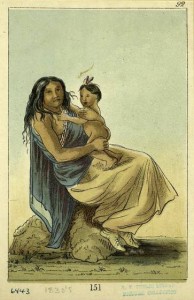Peace be with you my friends! Often I have blogged about various aspects of New Orleans Voodoo practice and their historical roots. Today I would like to share with you part of an article I wrote several years ago about the influence of the 19th century French philosopher Allen Kardec and his doctrine of Spiritism on New Orleans Voodoo and the types of spirit guides commonly found in New Orleans. In this first installment, I will be discussing the reverence for Louisiana’s first inhabitants, the Native-American people.
Voodoo pays a great deal of respect to the land and its past inhabitants.
 In addition the traditional African and Catholic practices, Voodoo, being true to its syncretic nature, also adopted and incorporated the teachings of 19th century French penseur Allan Kardec into its repertoire of beliefs and practices. Allan Kardec was the penname of Hippolyte Léon Denizard Rivail the founder of the doctrine of Spiritism, which is followed by many as a religion. Kardec taught that after death, souls remain in a state of limbo in which they must work off their karmic debt in order to free themselves of the excess spiritual weight that inhibits them from moving closer to God. Souls may work off their karmic debt by helping individuals on the earthly plane and in rare cases it may be necessary for a soul to become incarnate again to atone for serious sins. Spiritism also teaches that on Earth, people may help to elevate their spirit guides by offering prayers and by leaving glasses of water and white candles in a special place in their home reserved for meditation. By working with one’s spirit guides, it is possible to attain material success in this life and a higher station in the afterlife. Kardec even tried to reconcile his doctrines to traditional church teachings in his work, The Gospel According to Spiritism. Despite his scholarly attempt, Spiritism was condemned by the church hierarchy but nevertheless found a following among the members of European high society who enjoyed gathering in their parlors and communing with spirits as a form of entertainment. While Spiritism was little more than a passing fad in Europe, Kardec’s works were translated into Spanish and Portuguese and the Spiritist religion soared to undreamed-of levels of popularity in Latin America where it still has millions of followers. One of the places Spiritism caught on was in New Orleans where adherante to Voodoo eagerly incorporated Kardec’s teachings into their own eclectic practices, perhaps because some of his doctrines were right in line with their previously held beliefs concerning the state of Purgatory and ever older ideas handed down from their African ancestors .
In addition the traditional African and Catholic practices, Voodoo, being true to its syncretic nature, also adopted and incorporated the teachings of 19th century French penseur Allan Kardec into its repertoire of beliefs and practices. Allan Kardec was the penname of Hippolyte Léon Denizard Rivail the founder of the doctrine of Spiritism, which is followed by many as a religion. Kardec taught that after death, souls remain in a state of limbo in which they must work off their karmic debt in order to free themselves of the excess spiritual weight that inhibits them from moving closer to God. Souls may work off their karmic debt by helping individuals on the earthly plane and in rare cases it may be necessary for a soul to become incarnate again to atone for serious sins. Spiritism also teaches that on Earth, people may help to elevate their spirit guides by offering prayers and by leaving glasses of water and white candles in a special place in their home reserved for meditation. By working with one’s spirit guides, it is possible to attain material success in this life and a higher station in the afterlife. Kardec even tried to reconcile his doctrines to traditional church teachings in his work, The Gospel According to Spiritism. Despite his scholarly attempt, Spiritism was condemned by the church hierarchy but nevertheless found a following among the members of European high society who enjoyed gathering in their parlors and communing with spirits as a form of entertainment. While Spiritism was little more than a passing fad in Europe, Kardec’s works were translated into Spanish and Portuguese and the Spiritist religion soared to undreamed-of levels of popularity in Latin America where it still has millions of followers. One of the places Spiritism caught on was in New Orleans where adherante to Voodoo eagerly incorporated Kardec’s teachings into their own eclectic practices, perhaps because some of his doctrines were right in line with their previously held beliefs concerning the state of Purgatory and ever older ideas handed down from their African ancestors .
True to their instinct of survival and reverence for the past, Voodooists Africanized the Spiritist pratices as outlined by Kardec. This can be seen most clearly in the categories of spirits served by New Orleans Voodoo practitioners.
 The Indian Sprits-As in all animistic religions, Voodoo pays a great deal of respect to the land and its past inhabitants. For this reason, on many spirit altars in New Orleans you will find statues of stereotypical Native American figures such as the medicine man, the chief and the princess; and often Indian-head pennies are placed on the altar. Most likely, these figures bear little resemblance to the indigenous people who once inhabited the region, but they are nevertheless included in the pantheon of “les morts” as a sign of respect for those who were there long before the Europeans or the Africans. People who venerate Indian spirits are often endowed with curative powers and blessed with good fortune. In New Orleans popular culture, the Indian figure represents good luck and Mardi Gras parades would not be complete without scores of fluorescent feather and twinkling sequin bedecked Indians.
The Indian Sprits-As in all animistic religions, Voodoo pays a great deal of respect to the land and its past inhabitants. For this reason, on many spirit altars in New Orleans you will find statues of stereotypical Native American figures such as the medicine man, the chief and the princess; and often Indian-head pennies are placed on the altar. Most likely, these figures bear little resemblance to the indigenous people who once inhabited the region, but they are nevertheless included in the pantheon of “les morts” as a sign of respect for those who were there long before the Europeans or the Africans. People who venerate Indian spirits are often endowed with curative powers and blessed with good fortune. In New Orleans popular culture, the Indian figure represents good luck and Mardi Gras parades would not be complete without scores of fluorescent feather and twinkling sequin bedecked Indians.
 I have a friend named Angie in Massachusetts who is a practitioner of Santería and Spiritism and she severs several native spirits. About six years ago, she moved to a house in Deerfield, Massachusetts, a region known to be haunted by the ghosts of Native Americans slaughtered during the French and Indian War. Shortly after moving in, she began to hear the persistent sound of drums at night and often smell wood smoke when no fires were lighted. Her five-year-old son began to complain of nightly visits from frightening, imposing figures that would materialize in his room as he was trying to sleep. Angie attributed this to an overactive imagination until one day while she was hanging clothes to dry she looked over her shoulder to see a smiling Indian woman with a child standing around a campfire. Then in an instant both of them vanished along with the fire.
I have a friend named Angie in Massachusetts who is a practitioner of Santería and Spiritism and she severs several native spirits. About six years ago, she moved to a house in Deerfield, Massachusetts, a region known to be haunted by the ghosts of Native Americans slaughtered during the French and Indian War. Shortly after moving in, she began to hear the persistent sound of drums at night and often smell wood smoke when no fires were lighted. Her five-year-old son began to complain of nightly visits from frightening, imposing figures that would materialize in his room as he was trying to sleep. Angie attributed this to an overactive imagination until one day while she was hanging clothes to dry she looked over her shoulder to see a smiling Indian woman with a child standing around a campfire. Then in an instant both of them vanished along with the fire.
Angie called me and related the events she and her son had witnessed. We decided to go see Wendy, a longtime friend of ours and renowned practitioner of Wicca, a Celtic Earth based religion. Wendy informed us that the Native American presence was nothing to be feared and that it could be turned into something positive. Together, we went to Angie’s house and prepared an ancestor feast for the ghostly inhabitants. We made small dishes of rice and beans, dumplings, and Indian pudding. We placed the dishes at the edge of the forest with a lighted white candle in the center of each dish. Wendy invoked the spirits and poured three splashes of water on the ground from a metal dish and then made a libation offering of rum. Angie then placed nine shiny pennies next to the food and told the spirits that she wanted to coexist peacefully with them. From that day on, she has maintained a close connection to the Native American spirit world and they have become her protectors and personals guides. On one occasion, while at work a Native spirit appeared to her and admonished her of a situation at home. She left the office in a hurry to arrive at home just in time to see the smoke coming from behind the washing machine due to an electrical malfunction. Thankfully, no damage was done to the house. In accordance with Wendy’s instructions, every Monday night, Angie takes a small amount of whatever food she herself has eaten, and leaves it at the edge of the woods along with a dish of water and a candle. When the candle in extinguished, inevitably an animal, usually a fox or a deer, but occasionally a bear or raccoon, will come and eat the food. Wendy takes this as a sign that she has made friends with the ghostly inhabitants of her land.
I hope you have enjoyed the first installment of this series of education articles. In the next installment, I will discuss the importance of African spirit guides in New Orleans Voodoo. If you would like to learn the identity of your own spirit guides or are interested in having a spirit feast performed, please do not hesitate to contact me.